
5 KITCHEN HACKS TO HELP YOU COOK MORE VEGETABLES
04/19/19 — Heydon Hatcher
Loading up on a bounty of fresh vegetables is the best way to eat healthily at home, but we know that working your way through a CSA box or market haul can sometimes be intimidating. The women at Club Home Made offer up some of their favorite tips to more easily create delicious food with those beautiful vegetables.
![]() Simple, gorgeous, and delicious. Salad and photo by Mackenzie Smith Kelley.
Simple, gorgeous, and delicious. Salad and photo by Mackenzie Smith Kelley.
1. Find Your Go-To
Having a couple of recipes* in your arsenal that will work with whatever vegetables you have is a wonderful way of avoiding veggie waste. And when we say recipe, we really mean a cooking technique. Some of our favorite dishes that work well with just about any seasonal vegetable are stir-fries, quiches, and tacos. If you're interested in strengthening your confidence to throw together a meal with whatever you have, check out Club Home Made. We're passionate about arming cooks and wanna-be-cooks with these kinds of skills.
![]() Ada and Becky from Club Home Made stocking up on veggies. Photo by Scott David Gordon.
Ada and Becky from Club Home Made stocking up on veggies. Photo by Scott David Gordon.
![]() Photo by Casey Willson.
Photo by Casey Willson.
I'm a firm believer that you don't need super fancy gadgetry to cook good food, but having a knife you love (that is sharp!) and a big and solid cutting board will make vegetable prep so much more enjoyable. Seriously. When I got my first grown-up knife, I was shocked to see that the non-serrated blade sliced through a tomato without any trouble. You shouldn't have to put any muscle behind chopping vegetables. A sharp knife should do the work for you. Head to YouTube to learn how to sharpen your knife, or do like me and get a professional to sharpen it at the farmers' market.
![]() Invest in a good knife like Megan! Photo by Scott David Gordon.
Invest in a good knife like Megan! Photo by Scott David Gordon.
![]() Don't overcrowd. Photo by Scott David Gordon.
Don't overcrowd. Photo by Scott David Gordon.
I have an enviable collection of beautiful ceramic bowls in my kitchen, but my most used bowl is the huge stainless steel mixing bowl I got at Ace Mart. I have a gorgeous cutting board from Straight Leg Ranch that I use for meat and cheese boards, but my favorite cutting board for daily use is a restaurant quality cutting board, also from Ace Mart. It's no-frills, easy to clean, and has a big enough surface area to chop all the vegetables. Again, give yourself some space.
In addition to a good knife and chopping surface, my two other most used items in the kitchen are my dutch oven and honestly, my set of glass pyrex storage containers. I use these to store pre-chopped vegetables (ready for quick cooking) and also leftovers. Speaking of leftovers, might I recommend this quick read to help you think about your leftovers (among other things) differently: The Everlasting Meal.
Freezing Leftovers: Steer clear of freezing dishes with dairy products in them, but if you're making meatballs, for example, consider making a double batch and freezing leftovers in single-serving containers for quick lunches when you ain't got nothing else. Making a big pot of beans? Make more than you need! I freeze cooked beans in 1 or 2 cup portions, which can easily be thrown into the microwave. Realize that you suddenly have an entire drawer full of beets? For the quickest of preservation, boil, peel, and then dice your extra beets and freeze for a ready-to-go addition to a smoothie or salad. This method can really be applied to just about anything you have too much of and is a wonderful way to avoiding wasting a vegetable you may be (momentarily) sick of. I promise you'll miss those beets and that chard come July.
Do yourself a favor, and label what you put in the fridge. Even if you think you'll remember, just stick a label on it. Because the more you start to use your freezer, the crazier it will get in there. Include the date. I try to eat frozen leftovers in about 4 months, and try to use up frozen vegetables/ingredients in about 7 months. Of course, the food will likely still be fine past these dates, but you'll start to lose flavor and texture.
Freezing Ingredients: Freeze other ingredients like freshly minced garlic and ginger paste, seasonal pesto, or tomato sauce. During tomato season: dedicate one lazy Sunday afternoon to hitting up the market, buying a bounty of tomatoes, and have nothing on your schedule except making and freezing tomato sauce. Consider making this tomato gimlet to fuel the enterprise.
![]() Frozen ingredients. Photo by Scott David Gordon.
Frozen ingredients. Photo by Scott David Gordon.
I have a sheet of paper taped to the side of my fridge: every time I add something to my freezer, I add it to the list. That way when I'm trying to cobble together a quick and easy meal, I can see what ingredients I have frozen at just a quick glance. Having the list up also is a visual reminder at all times that there are beautiful ingredients just begging to be used in the freezer. It helps me work through these things quickly, which facilitates this entire method of preservation. The more I utilize these ingredients when I'm out of fresh options or need to go to the store, the more space I have to then freeze them when the CSA box overfloweth.
For more tips on how to properly store your veggies, check out this JBG blog post. Storing your vegetables properly will extend their life, and avoid any incidents of veggie-shame that may accompany wasting delicious produce.
Hope you enjoyed these tips. Join Club Home Made's newsletter or follow along on their brand new Instagram for more veggie tips 'n tricks and recipe videos (to come!). Happy cooking!
![]() Kale bath. Photo by Scott David Gordon.
Kale bath. Photo by Scott David Gordon.
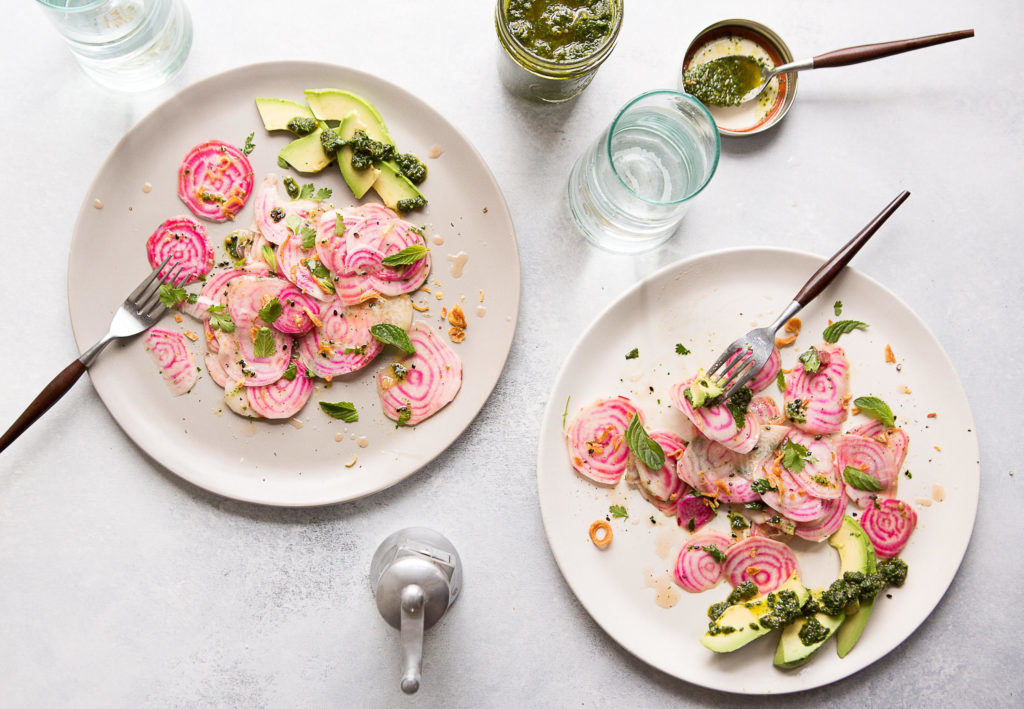 Simple, gorgeous, and delicious. Salad and photo by Mackenzie Smith Kelley.
Simple, gorgeous, and delicious. Salad and photo by Mackenzie Smith Kelley.
1. Find Your Go-To Recipes Cooking Methods
Having a couple of recipes* in your arsenal that will work with whatever vegetables you have is a wonderful way of avoiding veggie waste. And when we say recipe, we really mean a cooking technique. Some of our favorite dishes that work well with just about any seasonal vegetable are stir-fries, quiches, and tacos. If you're interested in strengthening your confidence to throw together a meal with whatever you have, check out Club Home Made. We're passionate about arming cooks and wanna-be-cooks with these kinds of skills.
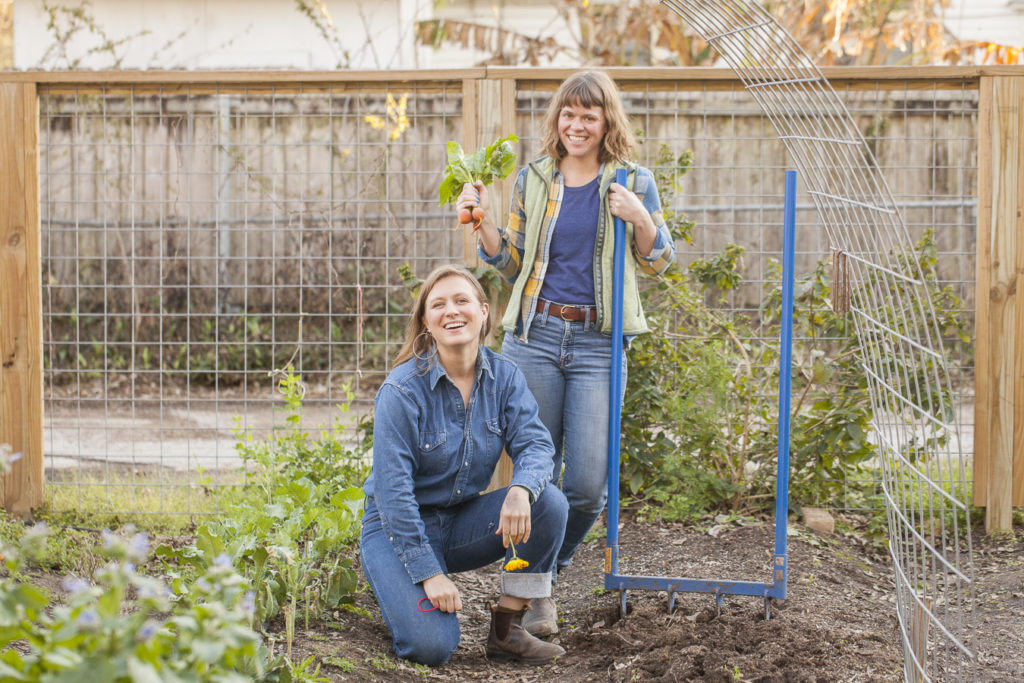 Ada and Becky from Club Home Made stocking up on veggies. Photo by Scott David Gordon.
Ada and Becky from Club Home Made stocking up on veggies. Photo by Scott David Gordon.
2. A Few of My Favorite Things...
Get a fancy-ish knife and good cutting board.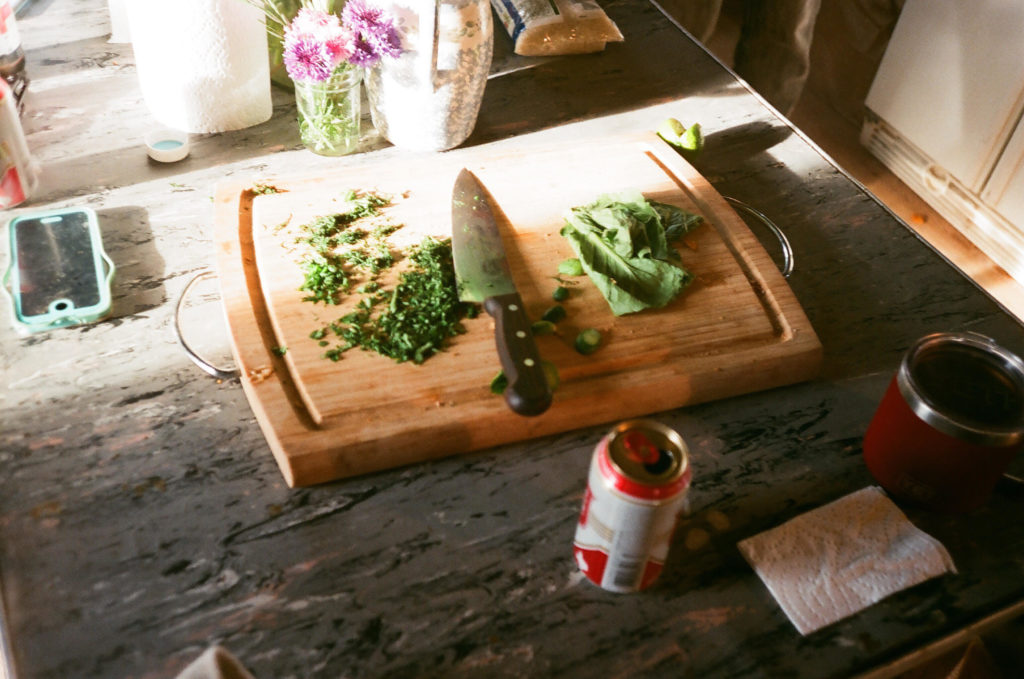 Photo by Casey Willson.
Photo by Casey Willson.
I'm a firm believer that you don't need super fancy gadgetry to cook good food, but having a knife you love (that is sharp!) and a big and solid cutting board will make vegetable prep so much more enjoyable. Seriously. When I got my first grown-up knife, I was shocked to see that the non-serrated blade sliced through a tomato without any trouble. You shouldn't have to put any muscle behind chopping vegetables. A sharp knife should do the work for you. Head to YouTube to learn how to sharpen your knife, or do like me and get a professional to sharpen it at the farmers' market.
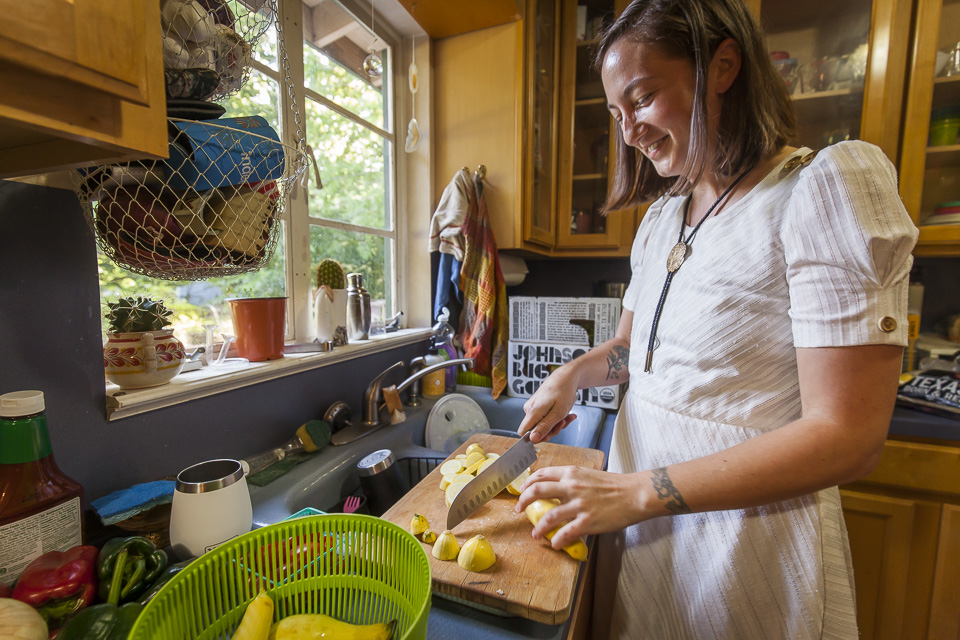 Invest in a good knife like Megan! Photo by Scott David Gordon.
Invest in a good knife like Megan! Photo by Scott David Gordon.
3. Don't Crowd
Don't overcrowd your pan, your pot, your bowl, or your cutting board. Food will brown better when it's spaced out in a pan, and mixing will be easier when you choose the right bowl. Your prep space will be better organized when you have room on your cutting board to chop multiple ingredients at once. When choosing a bowl or cutting board, I always choose one size larger than I think I need. And have never wished for a smaller vessel.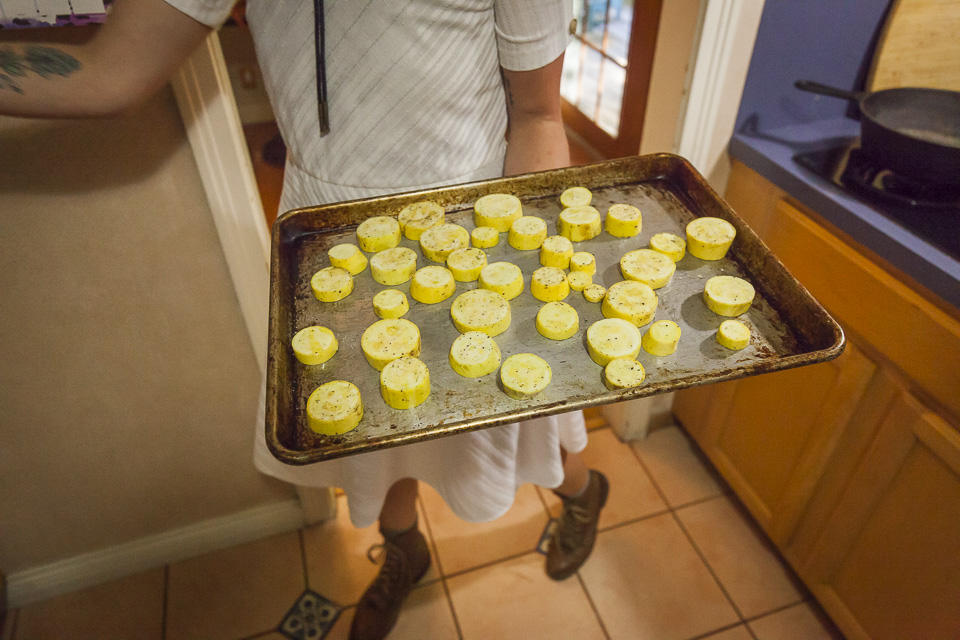 Don't overcrowd. Photo by Scott David Gordon.
Don't overcrowd. Photo by Scott David Gordon.
I have an enviable collection of beautiful ceramic bowls in my kitchen, but my most used bowl is the huge stainless steel mixing bowl I got at Ace Mart. I have a gorgeous cutting board from Straight Leg Ranch that I use for meat and cheese boards, but my favorite cutting board for daily use is a restaurant quality cutting board, also from Ace Mart. It's no-frills, easy to clean, and has a big enough surface area to chop all the vegetables. Again, give yourself some space.
In addition to a good knife and chopping surface, my two other most used items in the kitchen are my dutch oven and honestly, my set of glass pyrex storage containers. I use these to store pre-chopped vegetables (ready for quick cooking) and also leftovers. Speaking of leftovers, might I recommend this quick read to help you think about your leftovers (among other things) differently: The Everlasting Meal.
4. Become Friends with Your Freezer
Specifically, start to utilize your freezer space for things other than pizzas and frozen-potato products, which, for the record, we support. But, your freezer is also a wonderful way to store leftover meals, or even just components of future meals, for quick and easy use.Freezing Leftovers: Steer clear of freezing dishes with dairy products in them, but if you're making meatballs, for example, consider making a double batch and freezing leftovers in single-serving containers for quick lunches when you ain't got nothing else. Making a big pot of beans? Make more than you need! I freeze cooked beans in 1 or 2 cup portions, which can easily be thrown into the microwave. Realize that you suddenly have an entire drawer full of beets? For the quickest of preservation, boil, peel, and then dice your extra beets and freeze for a ready-to-go addition to a smoothie or salad. This method can really be applied to just about anything you have too much of and is a wonderful way to avoiding wasting a vegetable you may be (momentarily) sick of. I promise you'll miss those beets and that chard come July.
Do yourself a favor, and label what you put in the fridge. Even if you think you'll remember, just stick a label on it. Because the more you start to use your freezer, the crazier it will get in there. Include the date. I try to eat frozen leftovers in about 4 months, and try to use up frozen vegetables/ingredients in about 7 months. Of course, the food will likely still be fine past these dates, but you'll start to lose flavor and texture.
Freezing Ingredients: Freeze other ingredients like freshly minced garlic and ginger paste, seasonal pesto, or tomato sauce. During tomato season: dedicate one lazy Sunday afternoon to hitting up the market, buying a bounty of tomatoes, and have nothing on your schedule except making and freezing tomato sauce. Consider making this tomato gimlet to fuel the enterprise.
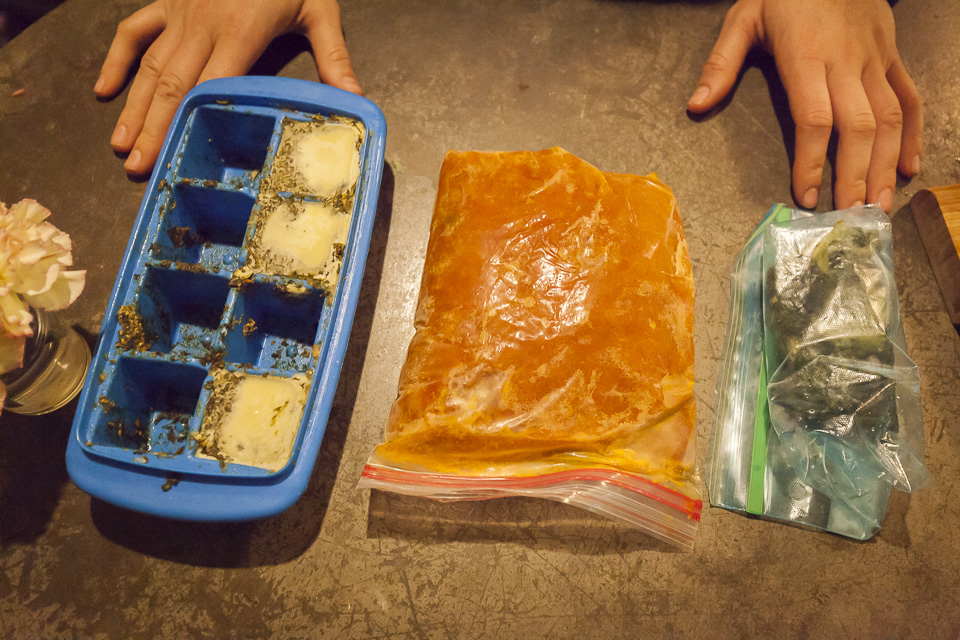 Frozen ingredients. Photo by Scott David Gordon.
Frozen ingredients. Photo by Scott David Gordon.
I have a sheet of paper taped to the side of my fridge: every time I add something to my freezer, I add it to the list. That way when I'm trying to cobble together a quick and easy meal, I can see what ingredients I have frozen at just a quick glance. Having the list up also is a visual reminder at all times that there are beautiful ingredients just begging to be used in the freezer. It helps me work through these things quickly, which facilitates this entire method of preservation. The more I utilize these ingredients when I'm out of fresh options or need to go to the store, the more space I have to then freeze them when the CSA box overfloweth.
5. Wash Your Veggies
Clean, wash, chop, and sort your veggies when they arrive in your kitchen. Sourcing vegetables straight from a farm means your vegetables are closer to their harvest date... aka, fresher. This means vegetables that are far superior in flavor and also in nutritional value. We all know that sometimes vegetables that come straight from a farm may arrive in your kitchen with a story to tell. "I'm a carrot! I grow underground, and to prove it, here's a little dirt." Grocery stores have primed us to expect spotless vegetables, void of any trace of how they actually grew. If you're new to getting farm-fresh vegetables, do yourself a favor and get them immediately ready for cooking when they arrive at the house. This will help you get used to your organic, homegrown, and superior tasting vegetables from the farm.For more tips on how to properly store your veggies, check out this JBG blog post. Storing your vegetables properly will extend their life, and avoid any incidents of veggie-shame that may accompany wasting delicious produce.
Hope you enjoyed these tips. Join Club Home Made's newsletter or follow along on their brand new Instagram for more veggie tips 'n tricks and recipe videos (to come!). Happy cooking!
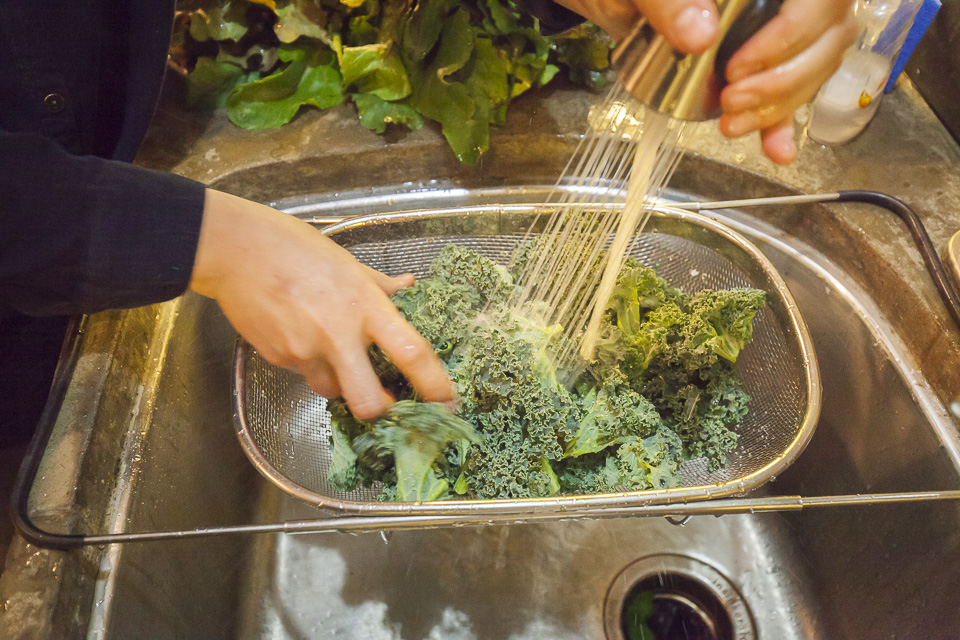 Kale bath. Photo by Scott David Gordon.
Kale bath. Photo by Scott David Gordon.





 0 ITEMS IN CART
0 ITEMS IN CART 

